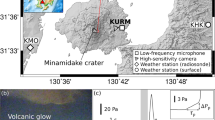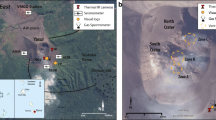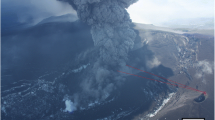Abstract
Forward Looking Infrared Radiometer (FLIR) cameras offer a unique view of explosive volcanism by providing an image of calibrated temperatures. In this study, 344 eruptive events at Stromboli volcano, Italy, were imaged in 2001–2004 with a FLIR camera operating at up to 30 Hz. The FLIR was effective at revealing both ash plumes and coarse ballistic scoria, and a wide range of eruption styles was recorded. Eruptions at Stromboli can generally be classified into two groups: Type 1 eruptions, which are dominated by coarse ballistic particles, and Type 2 eruptions, which consist of an optically-thick, ash-rich plume, with (Type 2a) or without (Type 2b) large numbers of ballistic particles. Furthermore, Type 2a plumes exhibited gas thrust velocities (>15 m s−1) while Type 2b plumes were limited to buoyant velocities (<15 m s−1) above the crater rim. A given vent would normally maintain a particular gross eruption style (Type 1 vs. 2) for days to weeks, indicating stability of the uppermost conduit on these timescales. Velocities at the crater rim had a range of 3–101 m s−1, with an overall mean value of 24 m s−1. Mean crater rim velocities by eruption style were: Type 1 = 34 m s−1, Type 2a = 31 m s−1, Type 2b = 7 m s−1. Eruption durations had a range of 6–41 s, with a mean of 15 s, similar among eruption styles. The ash in Type 2 eruptions originates from either backfilled material (crater wall slumping or ejecta rollback) or rheological changes in the uppermost magma column. Type 2a and 2b behaviors are shown to be a function of the overpressure of the bursting slug. In general, our imaging data support a broadening of the current paradigm for strombolian behavior, incorporating an uppermost conduit that can be more variable than is commonly considered.










Similar content being viewed by others
References
Allard P, Carbonnelle J, Metrich N, Loyer H, Zettwoog P (1994) Sulphur output and magma degassing budget of Stromboli volcano. Nature 368:326–330
Blackburn EA, Wilson L, Sparks RSJ (1976) Mechanisms and dynamics of strombolian activity. J Geol Soc London 132:429–440
Booth B, Walker GPL (1973) Ash deposits from the new explosion crater, Etna 1971. Phil Trans R Soc London A274:147–161
Calvari S, Pinkerton H (2004) Birth, growth and morphologic evolution of the “Laghetto” cinder cone during the 2001 Etna eruption. J Volcanol Geotherm Res 132:225–239, DOI 10.1016/S0377-0273(03)00347-0
Calvari S, Spampinato L, Lodato L, Harris AJL, Patrick MR, Dehn J, Burton MR, Andronico D (2005) Chronology and complex volcanic processes during the 2002–2003 flank eruption at Stromboli volcano (Italy) reconstructed from direct observations and surveys with a handheld thermal camera. J Geophys Res 110:B02201, DOI 10.1029/2004JB003129
Chouet B, Hamisevicz N, McGetchin TR (1974) Photoballistics of volcanic jet activity at Stromboli, Italy. J Geophys Res 79:4961–4976
Chouet B, Saccorotti G, Dawson P, Martini M, Scarpa R, De Luca G, Milana G, Cattaneo M (1999) Broadband measurements of the sources of explosions at Stromboli volcano. Geophys Res Lett 26:1937–1940
Chouet B, Dawson P, Ohminato T, Martini M, Saccorotti G, Giudicepietro F, De Luca G, Milana G, Scarpa R (2003) Source mechanisms of explosions at Stromboli Volcano, Italy, determined from moment-tensor inversions of very-long-period data. J Geophys Res 108:2019, DOI 10.1029/2002JB001919
Dehn J, Harris AJL, Ripepe M (2001) Infrared imaging of Strombolian eruptions. Eos Trans AGU 82(47) (Fall Meet Suppl, V52C-01)
Foshag WF, Gonzalez-Reyna J (1956) Birth and development of Paricutin volcano. US Geol Surv Bull 965-D:355–489
Francalanci L, Tommasini S, Conticelli S (2004) The volcanic activity of Stromboli in the 1906–1998 AD period: mineralogical, geochemical and isotope data relevant to the understanding of the plumbing system. J Volcanol Geotherm Res 131:179–211, DOI 10.1016/S0377-0273(03)00362-7
Francis P (1993) Volcanoes—a planetary perspective. Oxford University Press, Oxford
Giberti G, Jaupart C, Sartoris G (1992) Steady-state operation of Stromboli volcano, Italy: constraints on the feeding system. Bull Volcanol 54:535–541
Guest JE (1982) Styles of eruption and flow morphology on Mt Etna. Mem Soc Geol Ital 23:49–73
Harris AJL, Stevenson DS (1997) Magma budgets and steady-state activity of Vulcano and Stromboli. Geophys Res Lett 24:1043–1046
Heiken G (1978) Characteristics of tephra from Cinder Cone, Lassen Volcanic National Park, California. Bull Volcanol 41:119–130
Hort M, Seyfried R (1998) Volcanic eruption velocities measured with a micro radar. Geophys Res Lett 25:113–116
Hort M, Seyfried R, Voge M (2003) Radar Doppler velocimetry of volcanic eruptions: theoretical considerations and quantitative documentation of changes in eruptive behavior at Stromboli volcano, Italy. Geophys J Int 154:515–532, DOI 10.1046/j.1365-246X.2003.01982.x
Houghton BF, Schmincke H-U (1989) Rothenberg scoria cone, East Eifel: a complex Strombolian and phreatomagmatic volcano. Bull Volcanol 52:28–48
Jaupart C, Vergniolle S (1988) Laboratory models of Hawaiian and Strombolian eruptions. Nature 331:58–60
Kirchdorfen M (1999) Analysis and quasistatic FE modeling of long period impulsive events associated with explosions at Stromboli volcano (Italy). Ann Geophys 42:379–391
Lautze N, Houghton BF (2005) Physical mingling of magma and complex eruption dynamics in the shallow conduit at Stromboli volcano, Italy. Geology 33:425–428, DOI 10.1130/G21325.1
Macdonald GA (1972) Volcanoes. Prentice-Hall, Englewood Cliffs, NJ
Marchetti E, Ripepe M (2005) Stability of the seismic source during effusive and explosive activity at Stromboli Volcano. Geophys Res Lett 32:L03307, DOI 10.1029/2004GL021406
McGetchin TR, Chouet BA (1979) Energy budget of the volcano Stromboli, Italy. Geophys Res Lett 6:317–320
McGetchin TR, Settle M, Chouet BA (1974) Cinder cone growth modeled after Northeast Crater, Mount Etna, Sicily. J Geophys Res 79:3257–3272
Murata KJ, Dondoli C, Saenz R (1966) The 1963–65 eruption of Irazú Volcano, Costa Rica (The period of March 1963 to October 1964). Bull Volcanol 29:765–796
Ntepe N, Dorel J (1990) Observations of seismic volcanic signals at Stromboli volcano (Italy). J Volcanol Geotherm Res 43:235–251
Parfitt EA (2004) A discussion of the mechanisms of explosive basaltic eruptions. J Volcanol Geotherm Res 134:77–107, DOI 10.1016/j.jvolgeores.2004.01.002
Parfitt EA, Wilson L (1995) Explosive volcanic eruptions—IX. The transition between Hawaiian-style lava fountaining and Strombolian explosive activity. Geophys J Int 121:226–232
Patrick M (2007) Dynamics of strombolian ash plumes from thermal (FLIR) video: motion, morphology and air entrainment. J Geophys Res (in press)
Riedel C, Ernst GGJ, Riley M (2003) Controls on the growth and geometry of pyroclastic constructs. J Volcanol Geotherm Res 127:121–152, DOI 10.1016/S0377-0273(03)00196-3
Ripepe M (1996) Evidence for gas influence on volcanic seismic signals recorded at Stromboli. J Volcanol Geotherm Res 70:221–233
Ripepe M, Marchetti E (2002) Array tracking of infrasonic sources at Stromboli volcano. Geophys Res Lett 29:2076, DOI 10.1029/2002GL015452
Ripepe M, Rossi M, Saccorotti G (1993) Image processing of explosive activity at Stromboli. J Volcanol Geotherm Res 54:335–351
Ripepe M, Ciliberto S, Della Schiava M (2001) Time constraints for modeling source dynamics of volcanic explosions at Stromboli. J Geophys Res 106:8713–8727, DOI 10.1029/2000JB900374
Ripepe M, Marchetti E, Poggi P, Harris AJL, Fiaschi A, Ulivieri G (2004) Seismic, acoustic, and thermal network monitors the 2003 eruption of Stromboli volcano. Eos Trans AGU 85:329–336, DOI 10.1029/2004EO350001
Ripepe M, Marchetti E, Ulivieri G, Harris AJL, Dehn J, Burton M, Caltabiano T, Salerno G (2005) Effusive to explosive transition during the 2003 eruption of Stromboli volcano. Geology 33:341–344, DOI 10.1130/G21173.1
Self S, Sparks RSJ, Walker GPL, Booth B (1974) The 1973 Heimay strombolian scoria deposit, Iceland. Geol Mag 111:539–548
Self S, Kienle J, Huot J-P (1980) Ukinrek Maars, Alaska, II. Deposits and formation of the 1977 craters. J Volcanol Geotherm Res 7:39–65
Smithsonian Institution (2002) Stromboli volcano. Bull Glob Volcanism Netw 27:07
Sparks RSJ, Wilson L (1976) A model for the formation of ignimbrite by gravitational column collapse. J Royal Soc London 132:441–451
Sparks RSJ, Bursik MI, Carey SN, Gilbert JS, Glaze LS, Sigurdsson H, Woods AW (1997) Volcanic plumes. Wiley, Chichester
Steinberg GS, Babenko JI (1978) Experimental velocity and density determination of volcanic gases during eruption. J Volcanol Geotherm Res 3:89–98
Taddeucci J, Pompilio M, Scarlato P (2002) Monitoring the explosive activity of the July–August 2001 eruption of Mt Etna (Italy) by ash characterization. Geophys Res Lett 29:1029–1032, DOI 10.1029/2001GL014372
Taddeucci J, Pompilio M, Scarlato P (2004) Conduit processes during the July–August 2001 explosive activity of Mt Etna (Italy): inferences from glass chemistry and crystal size distribution of ash particles. J Volcanol Geotherm Res 137:33–54, DOI 10.1016/j.jvolgeores.2004.05.011
Urbanski N-A, Vöge M, Seyfried R, Rüpke L, Petersen T, Hanebuth T, Hort M (2002) Fifteen days of continuous activity survey at Stromboli volcano, Italy, in late September 2000: Doppler radar, seismicity, infrared, soil humidity and mapping of the crater region. Intl J Earth Sci 91:712–721, DOI 10.1007/s00531-001-0242-y
Valentine GA, Krier D, Perry FV, Heiken G (2005) Scoria cone construction mechanisms, Lathrop Wells volcano, southern Nevada, USA. Geology 33:629–632, DOI 10.1130/G21459.1
Vergniolle S, Brandeis G (1994) Origin of the sound generated by Strombolian explosions. Geophys Res Lett 21:1959–1962
Vergniolle S, Brandeis G (1996) Strombolian explosions. 1. A large bubble breaking at the surface of a lava column as a source of sound. J Geophys Res 101:20433–20447
Walker GPL (1973) Explosive volcanic eruptions—a new classification scheme. Geol Rundsch 62:431–446
Weill A, Brandeis G, Vergniolle S, Baudin F, Bilbille J, Fevre J-F, Piron B, Hill X (1992) Acoustic sounder measurements of the vertical velocity of volcanic jets at Stromboli volcano. Geophys Res Lett 19:2357–2360
Wilson L (1980) Relationships between pressure, volatile content, and ejecta velocity in three types of volcanic explosions. J Volcanol Geotherm Res 8:297–313
Wright R, Flynn LP (2003) On the retrieval of lava-flow surface temperatures from infrared satellite data. Geology 31:893–896, DOI 10.1130/G19645.1
Acknowledgements
This paper benefited greatly from discussions with N. Lautze, B. Houghton, L. Wilson, J. Hammer, L. Flynn, R. Wright, S. Fagents, S. Baloga, S. Self and J. Sumner. We thank J. Gagnon and B. Risser of FLIR Systems, Inc. for technical information regarding the cameras and G. Salerno (INGV) for weather data. J.L. Palma shared insights from his participation in the 2004 field campaign. We thank the Italian Department of Civil Protection for logistical support at Stromboli. Reviews by D. Swanson, R. Scandone, and an anonymous reviewer are greatly appreciated. This work was supported by NSF grant no. EAR-0207734, NERC grant no. NER/B/S/2001/00707, the USGS Volcano Hazards Program and the Geophysical Institute at the University of Alaska Fairbanks.
Author information
Authors and Affiliations
Corresponding author
Additional information
Editorial responsibility: R Cioni
Rights and permissions
About this article
Cite this article
Patrick, M.R., Harris, A.J.L., Ripepe, M. et al. Strombolian explosive styles and source conditions: insights from thermal (FLIR) video. Bull Volcanol 69, 769–784 (2007). https://doi.org/10.1007/s00445-006-0107-0
Received:
Accepted:
Published:
Issue Date:
DOI: https://doi.org/10.1007/s00445-006-0107-0




